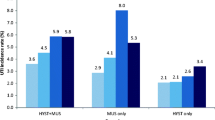Abstract
Purpose/Objective
To measure the impact of the placement of a midurethral sling (MUS) on development of urinary tract infections (UTI) in women with stress urinary incontinence.
Methods
This is an analysis of a large managed care organization MUS database from 2005 to 2016. The database was queried to identify UTI and diagnosis of recurrent UTI. The primary outcome was the UTI rate after MUS. Secondary outcomes included the recurrent UTI rate and rates of UTI over time.
Results
Over the study period, 13,404 MUS were performed. In the 12 postoperative months, 23% of patients developed a UTI, while 4% developed a de novo recurrent UTI diagnosis. UTIs were most frequently diagnosed in the 1st month, with the 7th postoperative day the most common. Predictors of UTI development included increased age (OR 3.69 [95% CI 2.58–5.26]), being diabetic (OR 1.43 [95% CI 1.28–1.60]), and having urinary retention requiring prolonged catheterization (OR 2.45 [95% CI 2.11–2.85]). UTIs were less likely to be diagnosed in those with transobturator MUS (OR 0.85 [95% CI 0.78–0.94]). Patients who developed a UTI were more likely to have a reoperation (p = 0.0147), including a reoperation for mesh revision/removal (p = 0.0287), and recurrent SUI (p = 0.0394). Patients who developed a UTI were more likely to develop postoperative de novo urgency urinary incontinence (UUI) (p < 0.0001).
Conclusion
Patients are at risk of UTI and rUTI after MUS. Risk of developing UTIs decreases with time. Predictors of developing UTI can help surgeons in the care of patients after MUS.


Similar content being viewed by others
References
Considerations about Surgical Mesh for SUI | FDA. https://www.fda.gov/medical-devices/urogynecologic-surgical-mesh-implants/considerations-about-surgical-mesh-sui. Accessed August 2, 2020
Ford AA, Rogerson L, Cody JD, Aluko P, Ogah JA. Mid-urethral sling operations for stress urinary incontinence in women. Cochrane Database Syst Rev. 2017;2017(7):CD006375. https://doi.org/10.1002/14651858.CD006375.pub4.
Barber MD, Brubaker L, Burgio KL, et al. Comparison of 2 transvaginal surgical approaches and perioperative behavioral therapy for apical vaginal prolapse: the OPTIMAL randomized trial. JAMA. 2014;311(10):1023–34. https://doi.org/10.1001/jama.2014.1719.
Foxman B. Epidemiology of urinary tract infections: Incidence, morbidity, and economic costs. Am J Med. 2002;113(1 Suppl. 1):5–13. https://doi.org/10.1016/S0002-9343(02)01054-9.
Hu KK, Boyko EJ, Scholes D, et al. Risk factors for urinary tract infections in postmenopausal women. Arch Intern Med. 2004;164(9):989–93. https://doi.org/10.1001/archinte.164.9.989.
Nygaard I, Brubaker L, Chai TC, et al. Risk factors for urinary tract infection following incontinence surgery https://doi.org/10.1007/s00192-011-1429-9.
Hammett J, Lukman R, Oakes M, Whitcomb EL. Recurrent urinary tract infection after midurethral sling. Female Pelvic Med Reconstr Surg. 2016;22(6):438–41. https://doi.org/10.1097/SPV.0000000000000308.
Weintraub AY, Reuven Y, Paz-Levy D, et al. Prevalence and risk factors for urinary tract infection up to one year following midurethral sling incontinence surgery. Eur J Obstet Gynecol Reprod Biol. 2018;222:146–50. https://doi.org/10.1016/j.ejogrb.2018.01.028.
Nygaard I, Brubaker L, Chai TC, et al. Risk factors for urinary tract infection following incontinence surgery. Int Urogynecol J. 2011;22(10):1255–65. https://doi.org/10.1007/s00192-011-1429-9.
Nguyen JN, Jakus-Waldman SM, Walter AJ, White T, Menefee SA. Perioperative complications and reoperations after incontinence and prolapse surgeries using prosthetic implants. Obstet Gynecol. 2012;119(3):539–46. https://doi.org/10.1097/AOG.0b013e3182479283.
Groutz A, Levin I, Gold R, Pauzner D, Lessing JB, Gordon D. “Inside-out” transobturator tension-free vaginal tape for management of occult stress urinary incontinence in women undergoing pelvic organ prolapse repair. Urology. 2010;76(6):1358–61. https://doi.org/10.1016/j.urology.2010.04.070.
Gehrich AP, Patzwald JR, Kern ME, Squires CC, Lustik MB. The incidence of early and recurrent urinary tract infections after midurethral sling operations. Mil Med. 2014;179(11):1301–6. https://doi.org/10.7205/MILMED-D-14-00122.
Berger AA, Tan-Kim J, Menefee SA. Long-term risk of reoperation after synthetic mesh midurethral sling surgery for stress urinary incontinence. Obstet Gynecol. 2019;134(5):1047–55. https://doi.org/10.1097/AOG.0000000000003526.
Gould MK, Tang T, Liu ILA, et al. Recent trends in the identification of incidental pulmonary nodules. Am J Respir Crit Care Med. 2015;192(10):1208–14. https://doi.org/10.1164/rccm.201505-0990OC.
Anger JT, Litwin MS, Wang Q, Pashos CL, Rodríguez LV. Complications of sling surgery among female medicare beneficiaries. Obstet Gynecol. 2007;109(3):707–14. https://doi.org/10.1097/01.AOG.0000255975.24668.f2.
Doganay M, Cavkaytar S, Kokanali MK, Ozer I, Aksakal OS, Erkaya S. Risk factors for postoperative urinary tract infection following midurethral sling procedures. Eur J Obstet Gynecol Reprod Biol. 2017;211:74–7. https://doi.org/10.1016/j.ejogrb.2017.02.006.
Vigil HR, Mallick R, Nitti VW, Lavallée LT, Breau RH, Hickling DR. Risk factors for urinary tract infection following mid urethral sling surgery. J Urol. 2017;197(5):1268–73. https://doi.org/10.1016/j.juro.2016.12.093.
Schimpf MO, Rahn DD, Wheeler TL, et al. Sling surgery for stress urinary incontinence in women: A systematic review and metaanalysis. Am J Obstet Gynecol. 2014;211(1):71.e1–71.e27. https://doi.org/10.1016/j.ajog.2014.01.030.
Ripperda CM, Kowalski JT, Chaudhry ZQ, et al. Predictors of early postoperative voiding dysfunction and other complications following a midurethral sling. Am J Obstet Gynecol. Mosby Inc. 2016;215:656.e1–6. https://doi.org/10.1016/j.ajog.2016.06.010.
Jackson D, Higgins E, Bracken J, Yandell PM, Shull B, Foster RT. Antibiotic prophylaxis for urinary tract infection after midurethral sling: a randomized controlled trial. Female Pelvic Med Reconstr Surg. 2013;19(3):137–41. https://doi.org/10.1097/SPV.0b013e318285ba53.
Swartz M, Ching C, Gill B, et al. Risk of infection after Midurethral synthetic sling surgery: are postoperative antibiotics necessary? Urology. 2010;75(6):1305–8. https://doi.org/10.1016/j.urology.2009.11.081.
Foxman B, Cronenwett AEW, Spino C, Berger MB, Morgan DM. Cranberry juice capsules and urinary tract infection after surgery: Results of a randomized trial. Am J Obstet Gynecol. 2015;213(2):194.e1–8. https://doi.org/10.1016/j.ajog.2015.04.003.
Acknowledgments
The research is supported by a grant from the Regional Research Committee of Kaiser Permanente Southern California, grant no. KP-RRC-20171101. The authors thank Stephanie Tovar for her coordination of support and resources at the regional research committee. The authors thank Zoe Li for assistance with data management. The authors thank Liz Walton-Paxton and her team for assistance with mesh implant registry applications.
Author information
Authors and Affiliations
Corresponding author
Ethics declarations
Conflict of interest
None.
Additional information
Publisher’s note
Springer Nature remains neutral with regard to jurisdictional claims in published maps and institutional affiliations.
Rights and permissions
About this article
Cite this article
Berger, A.A., Tan-Kim, J. & Menefee, S.A. The impact of midurethral sling surgery on the development of urinary tract infections. Int Urogynecol J 33, 829–834 (2022). https://doi.org/10.1007/s00192-021-04779-x
Received:
Accepted:
Published:
Issue Date:
DOI: https://doi.org/10.1007/s00192-021-04779-x




